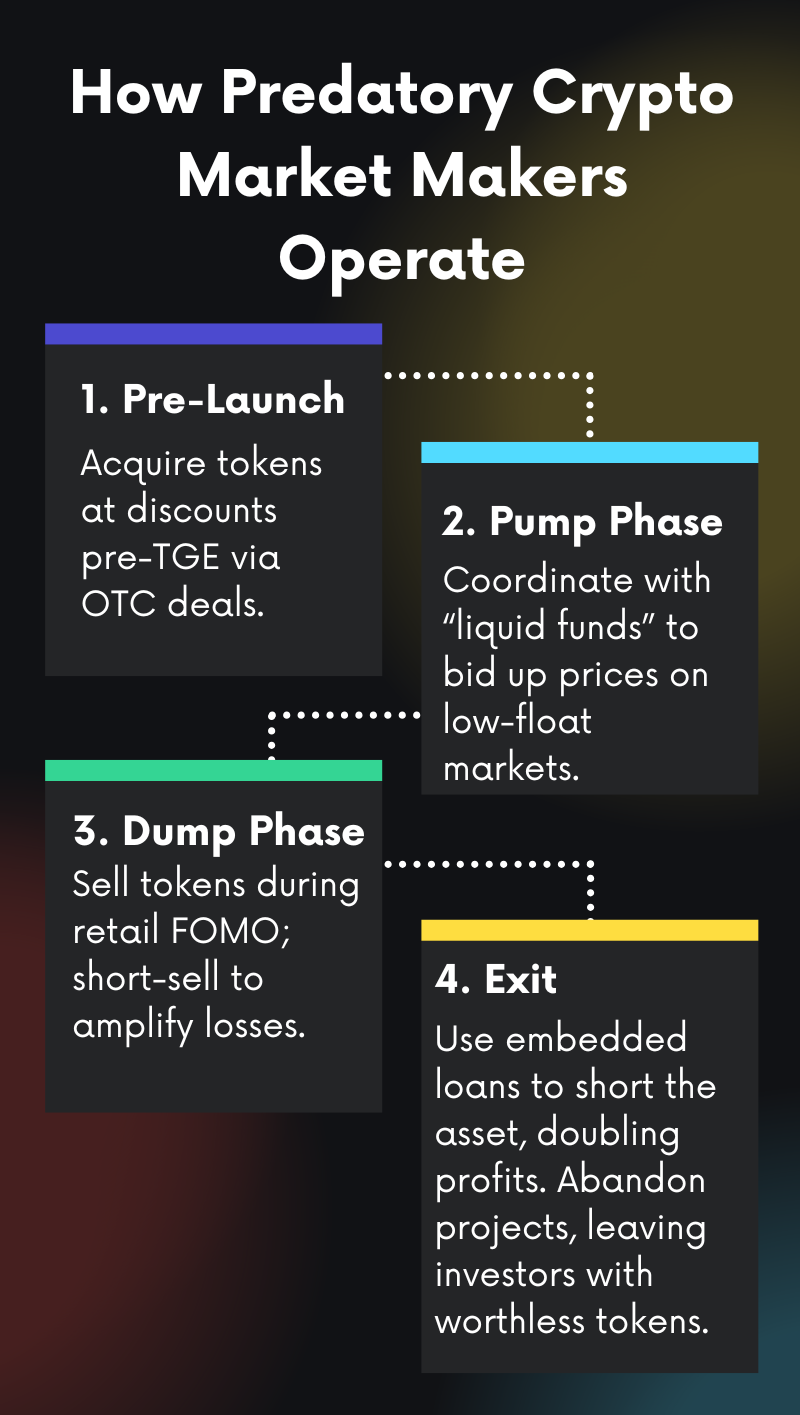Synthetix founder Kain Warwick reveals how predatory crypto market makers exploit call options and low-float tokens, harming projects and traders. Learn the red flags and how to avoid becoming “exit liquidity.”
What Are Crypto Market Makers – And Why Do They Matter?
Market Makers (MMs) in the crypto space facilitate liquidity in trading markets by consistently making markets by quoting both buy and sell prices for assets. More generally, their primary function is to minimize the bid-ask spread and absorb capital markets’ volatility so traders can confidently place orders and are less likely to see volatile price action. Legitimate MMs, like those using delta-neutral strategies, balance their positions to avoid directional risk. For example, if they buy 100 ETH, they might short-sell futures to hedge against price drops.
Why Projects Use Them:
- Exchange Listings: Many exchanges require proof of liquidity before listing tokens.
- Investor Confidence: Deep-order books attract institutional investors.
- Price Stability: MMs prevent wild price fluctuations during high volatility.
But as Synthetix founder Kain Warwick reveals, not all market makers play by the rules.
The Hidden World of Crypto Market Makers: Guardians or Predators?
Crypto Market Makers (MMs) are the invisible architects of liquidity in digital asset markets. By continuously quoting buy and sell prices, they ensure traders can execute orders smoothly. But as Synthetix founder Kain Warwick warns in a viral tweet thread, a darker side of market making has emerged—one fueled by call option manipulation, low-float schemes, and outright exploitation.
Kain Warwick’s Battle Against ‘Extraction’ Tactics
In a candid Twitter thread, Warwick unpacked his decade-long battle with predatory MMs, highlighting systemic exploitation in crypto’s market-making ecosystem:
- The ICO-Era Shakedown (2017–2019):
- Startups were extorted into paying MMs 50K–50K–300K/month for fake liquidity and exchange listings.
- MMs artificially inflated trading volumes on Tier 3 exchanges by wash trading (crossing their own orders).
- The Call Option Scam Evolution:
- Post-2020, MMs shifted to demanding call options (rights to buy tokens at fixed prices) as payment.
- American vs. European Calls:
- American Calls: Allow instant token dumps, enabling MMs to pump and dump (e.g., Alameda Research), a tool Warwick alleges firms like DWF Labs exploited.
- European Calls: Only exercisable at expiry, limiting manipulation (used by ethical MMs like Jump Trading).
- The “Low-Float Meta” Playbook:
- MMs collude with projects to lock most tokens in vesting schedules, creating low liquidity.
- They then acquire discounted tokens pre-launch, pump prices via coordinated bids, and dump on retail traders.
The optimal play is to sell the loan into any bids, hold the call, and short the token. If the price crashes, they profit. If it pumps, they exercise the call to cover losses. Heads they win, tails you lose.
Warwick’s Warning:
“If a MM demands a giant token allocation upfront, they’re prepping you as exit liquidity.”
The Dark Evolution of Market Maker Contracts
Warwick’s thread highlights how MMs like Alameda Research (FTX’s sister firm) and DWF Labs pioneered the “low-float meta”:
- Secure Discounted Tokens Pre-TGE: MMs negotiate OTC deals to buy tokens at discounts pre-launch, often borrowing extra tokens to short-sell.
- Pump via Coordinated Bidding: Partner funds bid up prices on low-float markets, creating artificial demand.
- Dump & Short-Sell: MMs sell tokens at peak prices, then profit further by shorting the asset into oblivion.

In 2023, projects using such MMs saw tokens crash 60–90% post-launch, per analytics firm Chainalysis.
Why Ethical Market Makers Still Matter
Despite bad actors, reputable MMs remain critical for healthy markets:
- Tight Spreads: Reduce slippage for traders.
- Transparency: Provide real-time liquidity metrics.
- Risk Management: Stay delta-neutral to avoid influencing prices.
Key Takeaways from Kain’s Exposé
🔍 Red Flags for Projects:
- MMs demanding American-style call options.
- Large token allocations sent to MMs pre-launch.
- Vague “liquidity provision” agreements without spread targets.
🛡️ Defensive Measures:
- Demand European-style call structures.
- Partner with transparent MMs.
- Audit MM wallets for sudden token movements.
The Path Forward: Restoring Trust in Market-Making
Warwick’s revelations underscore the need for due diligence. While bad actors dominate headlines, ethical MMs remain critical for healthy markets. Projects must:
- Vetting Market Makers’ Partnerships: Review past transactions and tokenomics.
- Demand Transparency and Reporting: Demand real-time reporting on spreads and liquidity.
- Avoid OTC Temptations: Discounted token sales often precede exploitation.
While some exchanges are actively combating corrupt market makers, they still haven’t implemented Warwick’s very clear takeaway: “If a market maker offers you ‘exit liquidity’ run away from them, a real market maker puts a spread that is tight, not fairy tales.”



